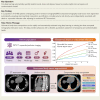Deep learning-quantified body composition from positron emission tomography/computed tomography and cardiovascular outcomes: a multicentre study
- PMID: 40159388
- PMCID: PMC12190801
- DOI: 10.1093/eurheartj/ehaf131
Deep learning-quantified body composition from positron emission tomography/computed tomography and cardiovascular outcomes: a multicentre study
Abstract
Background and aims: Positron emission tomography (PET)/computed tomography (CT) myocardial perfusion imaging (MPI) is a vital diagnostic tool, especially in patients with cardiometabolic syndrome. Low-dose CT scans are routinely performed with PET for attenuation correction and potentially contain valuable data about body tissue composition. Deep learning and image processing were combined to automatically quantify skeletal muscle (SM), bone and adipose tissue from these scans and then evaluate their associations with death or myocardial infarction (MI).
Methods: In PET MPI from three sites, deep learning quantified SM, bone, epicardial adipose tissue (EAT), subcutaneous adipose tissue (SAT), visceral adipose tissue (VAT), and intermuscular adipose tissue (IMAT). Sex-specific thresholds for abnormal values were established. Associations with death or MI were evaluated using unadjusted and multivariable models adjusted for clinical and imaging factors.
Results: This study included 10 085 patients, with median age 68 (interquartile range 59-76) and 5767 (57%) male. Body tissue segmentations were completed in 102 ± 4 s. Higher VAT density was associated with an increased risk of death or MI in both unadjusted [hazard ratio (HR) 1.40, 95% confidence interval (CI) 1.37-1.43] and adjusted (HR 1.24, 95% CI 1.19-1.28) analyses, with similar findings for IMAT, SAT, and EAT. Patients with elevated VAT density and reduced myocardial flow reserve had a significantly increased risk of death or MI (adjusted HR 2.49, 95% CI 2.23-2.77).
Conclusions: Volumetric body tissue composition can be obtained rapidly and automatically from standard cardiac PET/CT. This new information provides a detailed, quantitative assessment of sarcopenia and cardiometabolic health for physicians.
Keywords: Body composition; Deep learning; Positron emission tomography; Risk Stratification.
© The Author(s) 2025. Published by Oxford University Press on behalf of the European Society of Cardiology.
Figures






References
-
- Patel KK, Spertus JA, Chan PS, Sperry BW, Al Badarin F, Kennedy KF, et al. Myocardial blood flow reserve assessed by positron emission tomography myocardial perfusion imaging identifies patients with a survival benefit from early revascularization. Eur Heart J 2020;41:759–68. 10.1093/eurheartj/ehz389 - DOI - PMC - PubMed
Publication types
MeSH terms
Grants and funding
LinkOut - more resources
Full Text Sources
Research Materials

